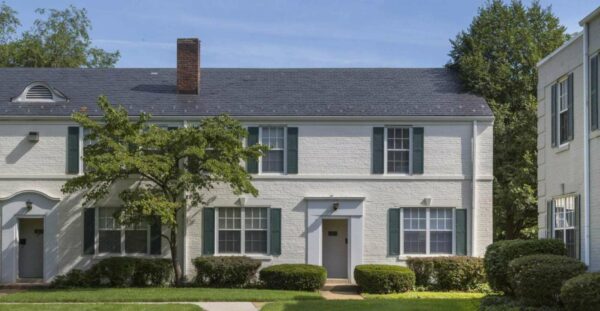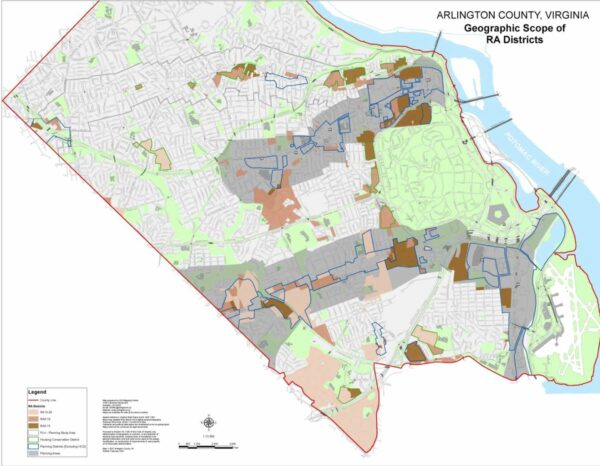 Making Room is a biweekly opinion column. The views expressed are solely the author’s.
Making Room is a biweekly opinion column. The views expressed are solely the author’s.
Every year, Arlington loses market-rate affordable housing (MARKs) as redevelopment and reinvestment turns older, lower-cost apartments into newer, higher-cost apartments.
We also lose committed affordable housing (CAFs) when the income and rental restrictions on properties built with public funds expire, typically after 30-60 years.
In 2027, Arlington could lose 500 MARKs and CAFs near the vibrant and desirable Ballston area when the term of committed affordability at the Ballston Park Apartments expires.
This would be a huge blow to the County’s Affordable Housing goals. Staff, advocates, and tenants should start now to create a plan to preserve this affordable housing stock as the landlord pursues it’s likely goal of redevelopment.
Ballston Park is a perfect case study for Arlington’s forthcoming Multifamily Reinvestment Study. Part of the Housing Arlington initiative, the Multifamily Reinvestment Study “seeks ways to stem the loss of market-rate affordable housing that occurs in multifamily apartment communities when property owners rehabilitate, redevelop, or add new units.”
The fate of Arlington’s aging garden-style apartments is one of the biggest challenges to current housing policy. They provide lower-cost housing to thousands of residents, largely due to their age and condition. But these properties are on scarce land that allows multi-family buildings as by-right development. They are prime targets for demolition and development as higher-cost townhomes, with no requirement to preserve or support affordable housing.
Ballston Park will present a greater challenge for preservation than previous efforts.
First, the property has limited parking lots, which means not as much space to build new housing at a higher price point to offset the cost of preserving affordable units. Second, Arlington doesn’t have the option of using historic designation to force the property owner (in this case Paradigm) to negotiate and maintain affordable units.
To preserve affordable homes for the hundreds of families at Ballston Park, and other tenants at low-cost, aging apartments throughout the County, Arlington should pursue three objectives:
1. Find policies that preserve 100% of the existing MARKs and expiring CAFs
The County should not be satisfied with partial preservation of our endangered market rate affordable housing (MARKs). Preserving the existing stock of lower-cost housing is more effective than building new Committed Affordable Housing (CAFs) using developer contributions or Arlington funds.
One nearby example is the Residential Affordability Zone as part of the South Patrick Affordability Strategy in Alexandria that is working toward 1-to-1 replacement of expiring CAF units at aging properties along Route 1.
2. Make it easier to build at a higher density in Arlington’s ‘unplanned’ areas
Ballston Park, like many garden-style apartments, is in an “unplanned” area of the County. This means that while the zoning allows for multifamily dwellings, there are few options for building above the baseline density. Developers have little reason to pursue anything but the by-right zoning on the site, which means they build the most expensive housing that the plot allows, and the community gets no additional housing and no public benefits.
The solution is not to halt change and leave these buildings as they are. Aging garden apartments need reinvestment to remain habitable, and many are located in areas of the County that warrant greater density to allow even more people to live near robust amenities. Making it easier for property owners to add more units means more opportunity to preserve existing lower-cost housing alongside higher-cost housing.
3. Take the pressure off low-cost apartment communities by allowing new-construction (such as townhomes) in more places.
The pressure to redevelop Ballston Park is due in part to limited zoning in single-family neighborhoods. Arlington has seen many cases of low-cost, medium density apartments getting torn down and replaced by townhomes. Townhomes are popular homes for people who can’t afford a newly-built detached home. Townhomes are allowed by-right in any multifamily districts, but prohibited in most single-family neighborhoods.
When we don’t expand housing options and housing supply throughout the county, all of the demand gets pushed in the few places where new housing is allowed. A lot of those places are home to lower-income residents who are at risk of getting pushed out. By allowing townhomes or duplexes in single-family neighborhoods, wealthy families have another option.
The clock is ticking on Ballston Park and other lower-cost apartment buildings as the competition for housing in Arlington grows and new construction fails to meet demand. We should look for ways to maintain and increase diverse types of housing so different kinds of families can live in our community.
If you want to help low-income residents, now is the time to get involved in the Multifamily Reinvestment Study so that our neighbors can stay in our community and help it thrive.
Jane Fiegen Green, an Arlington resident since 2015, proudly rents an apartment in Pentagon City with her family. By day, she is the Membership Director for Food and Water Watch, and by night she tries to navigate the Arlington Way. Opinions here are her own.



